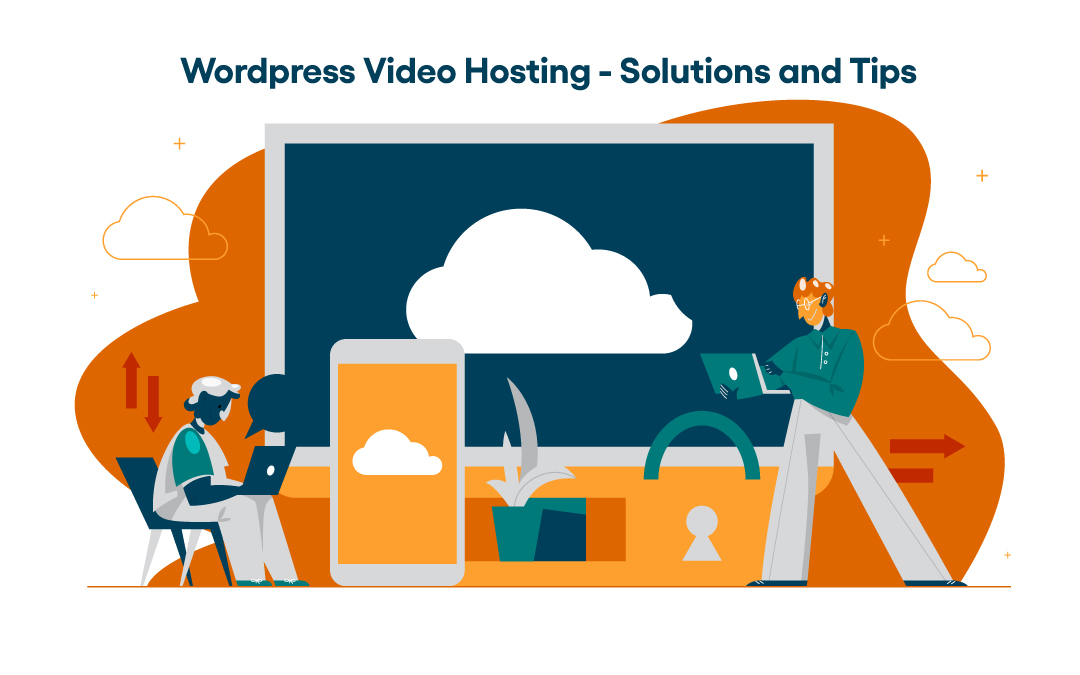Videos can transform your WordPress site into an engaging and dynamic experience for visitors. Whether you want to boost SEO, improve user retention, or increase social media shares, adding video content can help you stand out. But choosing the right way to host the videos is crucial to your site’s performance and user experience.
In this guide, we’ll walk you through the top video hosting options for WordPress, giving you the tools you need to decide what’s best for your site— whether that’s self-hosting or leveraging third-party sites like YouTube or Vimeo. We’ll also cover practical tips to help you get the most out of your video content. Let’s dive in.
Why Videos Matter on Your WordPress Site
Adding videos to your site can be a game-changer. Studies show that people retain more information from videos than from text, which makes it easier for your audience to connect with your message and act on it. Videos are also perfect for mobile users, who often prefer watching over reading, meaning you can reach a broader audience by optimizing your content for mobile consumption.
From an SEO perspective, videos can improve “dwell time”—the amount of time visitors spend on your pages—which helps boost your search rankings. Plus, creating a video sitemap can help search engines index your videos and further increase your visibility.
With video traffic expected to make up 82% of internet traffic, finding an easy, efficient way to host videos on your WordPress site is more important than ever.
Self-Hosting vs. Third-Party Hosting: What’s Right for You?
When it comes to video hosting, you have two main options: self-hosting or using a third-party platform. Each comes with its own set of benefits and trade-offs:

Self-Hosting
Self-hosting gives you full control over your videos. You can customize the player to match your brand, and you’re not relying on another platform’s rules or ads. But, self-hosting can slow down your site, eat up server space, and increase costs, especially if you don’t have a robust server.
Third-Party Hosting
Platforms like YouTube, Vimeo, and Spotlightr make it easy to upload and share your videos. They handle the bandwidth and offer features like automatic video quality adjustment, SEO tools, and wider audience reach. However, platforms like YouTube might show ads that can distract your viewers.
Ultimately, it comes down to your priorities. Do you want more control or more convenience?
Best Practices for Self-Hosting Videos
If you decide to self-host, these are ways to minimize potential drawbacks and keep your site running smoothly:
Optimize Your Video Files: Compressing your videos reduces their file size and improves video loading times without sacrificing quality. This makes for a faster and smoother user experience.
Use a CDN: A content delivery network (CDN) helps speed up video delivery by distributing your files across multiple servers worldwide. This reduces lag for users in different locations.
Enable Lazy Loading: Lazy loading ensures videos only load when a user scrolls to them, which enhances your site’s overall performance.
Check Upload Limits: Make sure your hosting provider supports large video file uploads. If not, you’ll need to adjust your settings or upgrade your hosting plan.
Top Third-Party Video Hosting Services for WordPress
While self-hosting offers control, third-party video hosting services can greatly improve video performance and usability on WordPress sites. Here’s a quick look at the best third-party platforms for hosting videos on WordPress:

YouTube
YouTube—the world’s second most popular search engine—is a powerhouse when it comes to video hosting. With over 122 million active users daily, it offers unparalleled reach and audience growth potential.
One of the major advantages of using YouTube is its robust SEO capabilities. YouTube videos often rank highly in search results and drive traffic back to your site. YouTube’s social sharing features can also help your videos go viral. But relying on YouTube means dealing with ads and potential distractions for your viewers.
Spotlightr
Spotlightr is an excellent choice for those who prioritize content privacy and protection. With HLS encryption, Spotlightr ensures that your video content is safeguarded against piracy. This focus on security is particularly beneficial for educational and e-learning platforms.
Spotlightr also offers a CDN to enhance video delivery speed and reliability, which provides a smooth viewing experience. Its plans are designed for growth and scalability, starting as low as $12 per month when billed yearly. Additionally, Spotlightr’s integration with WordPress allows users to manage their videos seamlessly within the platform.
Vimeo
Vimeo is well-regarded for its professional features and high-quality streaming capabilities. One of its standout features is advanced privacy settings, allowing users to control who can view their videos. This is particularly useful for businesses and content creators who need to protect their intellectual property.
Vimeo offers an ad-free experience and ensures that your viewers can focus on your content without interruptions. Its pricing starts at $12 per month, and it supports streaming high-quality videos up to 4K resolution. However, to access certain premium features, you’ll need to opt for higher-priced plans, which can be a limitation for some.
Wistia
Wistia specializes in providing video marketing solutions and offers extensive analytics features to help users gain insights into viewer interaction and engagement. Wistia also provides customization options for video players, enabling brands to align their video content with their overall branding strategy. These features make Wistia an excellent choice for businesses focused on using video as a key marketing tool.
JetPack VideoPress
JetPack VideoPress is designed specifically for WordPress, making it a seamless choice for WordPress users. It efficiently stores videos on their servers using a CDN, which ensures fast delivery. One of its key features is ad-free viewing, which enhances the user experience. VideoPress also allows users to upload videos directly from the WordPress media library, but despite its extensive features, it is not the cheapest option available.
How to Embed Videos on Your WordPress Site
Embedding videos into your WordPress site is easy, especially if you’re using third-party platforms. You can either paste the video’s URL directly into your WordPress editor to embed it automatically, or you can copy the embed code from the hosting platform and paste it into your site’s HTML editor.
For more control over how the video appears, platforms like Spotlightr allow serverless hosting and enhanced video performance through built-in CDNs.

4 Tips for Video Hosting with WordPress:
1. Protect Your Video Content
Security is crucial when hosting videos, as unauthorized access and piracy can undermine your efforts. Implementing access control ensures only authorized users can view or manage your video content, which is essential for sensitive or premium content.
To keep your videos safe:
– Control Access: Use password protection or restrict access to certain user groups.
– Encrypt Data: Ensure your video files are encrypted during transmission to prevent interception.
– Use DRM: Digital Rights Management (DRM) tools help prevent unauthorized copying and sharing of your videos.
2. Customize Your Video Player in WordPress
Customizing your video player can enhance user experience and align it with your site’s branding. Many video player plugins allow full customization, including altering player size, enabling autoplay and looping, and providing shortcode generators for easy embedding.
Applying various skins and custom CSS to match your site’s design aesthetics creates a cohesive look. Ensuring your video player is responsive is also crucial for compatibility across different devices.
3. Create Video Galleries and Playlists
Creating video galleries and playlists on your WordPress site enhances content organization and improves user navigation. If you’re using lots of videos, try organizing them into galleries or playlists. Plugins like FV Flowplayer Video Player or Easy Video Player make it easy to set up galleries and playlists that enhance the user experience.
4. Track Video Performance with Analytics
Understanding how viewers interact with your videos is crucial. Most video hosting platforms offer analytics that can show you watch times, drop-off points, and other engagement metrics. With this data, you can adjust your content strategy to better meet your audience’s needs and optimize your videos for higher conversion rates.

Final Thoughts
Whether you self-host or use a third-party platform, finding the right solution for video hosting can make or break your WordPress site’s performance and user experience. By following best practices and leveraging the right tools, you’ll keep your site fast, secure, and engaging for all your visitors. With the rise of video content, now’s the time to ensure your site is ready to keep up.
Frequently Asked Questions
What are the benefits of adding videos to my WordPress site?
Videos can significantly boost engagement on your site. They hold attention longer than text, which improves SEO by increasing the time visitors spend on your pages. This leads to better search rankings, more traffic, and a more engaged audience.
Should I self-host my videos or use a third-party platform?
Using a third-party platform like YouTube or Vimeo is generally easier and more scalable. These platforms offer built-in SEO features and don’t strain your server. Self-hosting gives you full control but can slow down your site and limit customization. Choose based on your site’s needs and resources.
How can I improve video performance on my WordPress site?
To keep your videos running smoothly, compress the files to reduce load times, use a content delivery network (CDN) to speed up delivery, and enable lazy loading so videos only load when needed. Also, make sure your video player is responsive for a seamless experience across devices.
What security steps should I take when hosting videos?
To protect your video content, control who can access it by using password protection or other access tools. Encrypt your videos during transmission to keep them secure, and use Digital Rights Management (DRM) to prevent unauthorized sharing. Regular backups also ensure you won’t lose important content.
How can I track how well my videos are performing?
Most hosting platforms offer built-in analytics that show key metrics like watch time and where viewers drop off. Use this data to refine your content strategy and improve viewer engagement.
Spotlightr Video Hosting For Your Course
Discover why Spotlightr is the #1 choice for course creators and e-learning professionals.
Register for a free 2 week trial, no credit card required.

